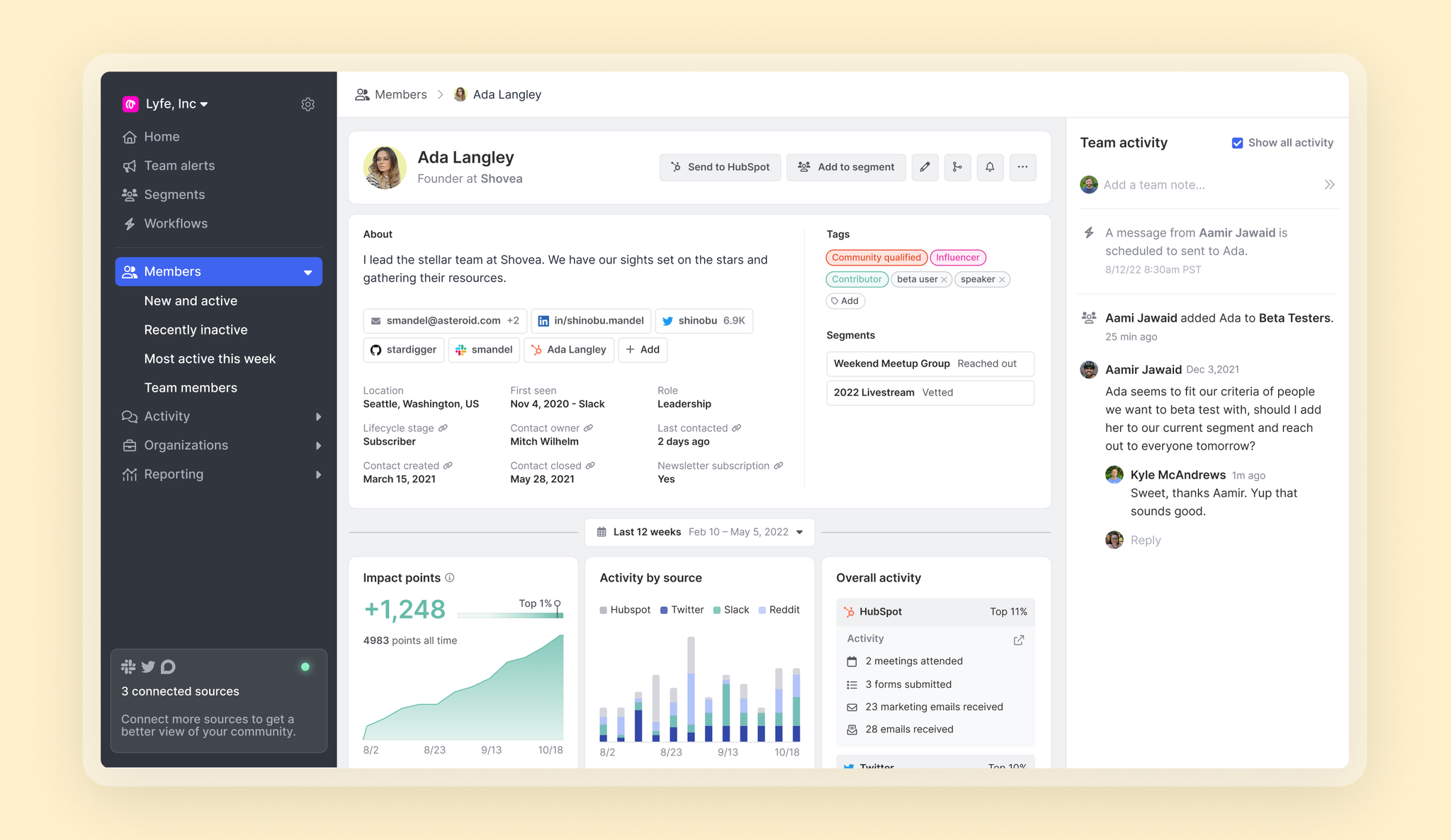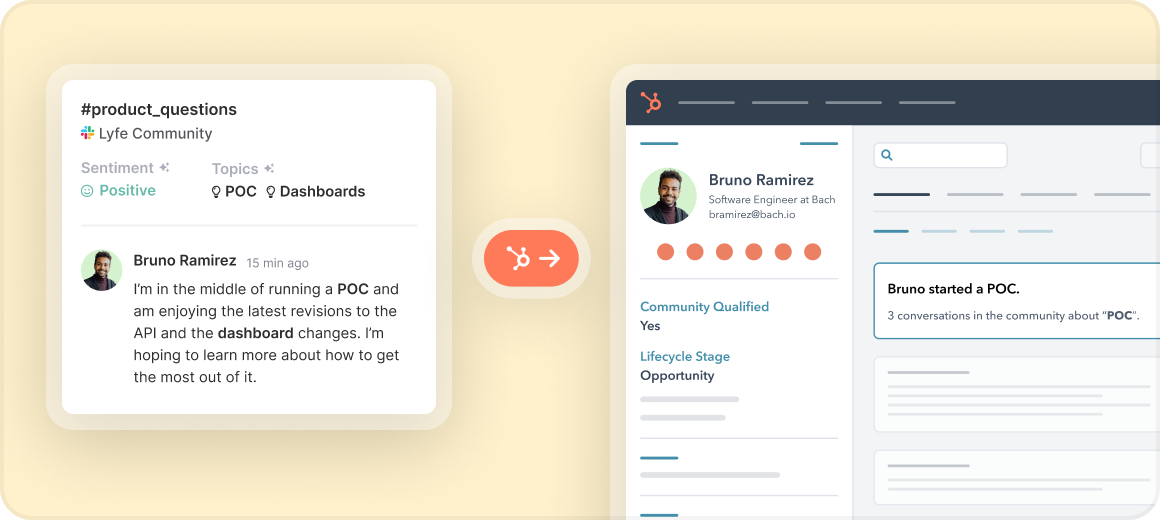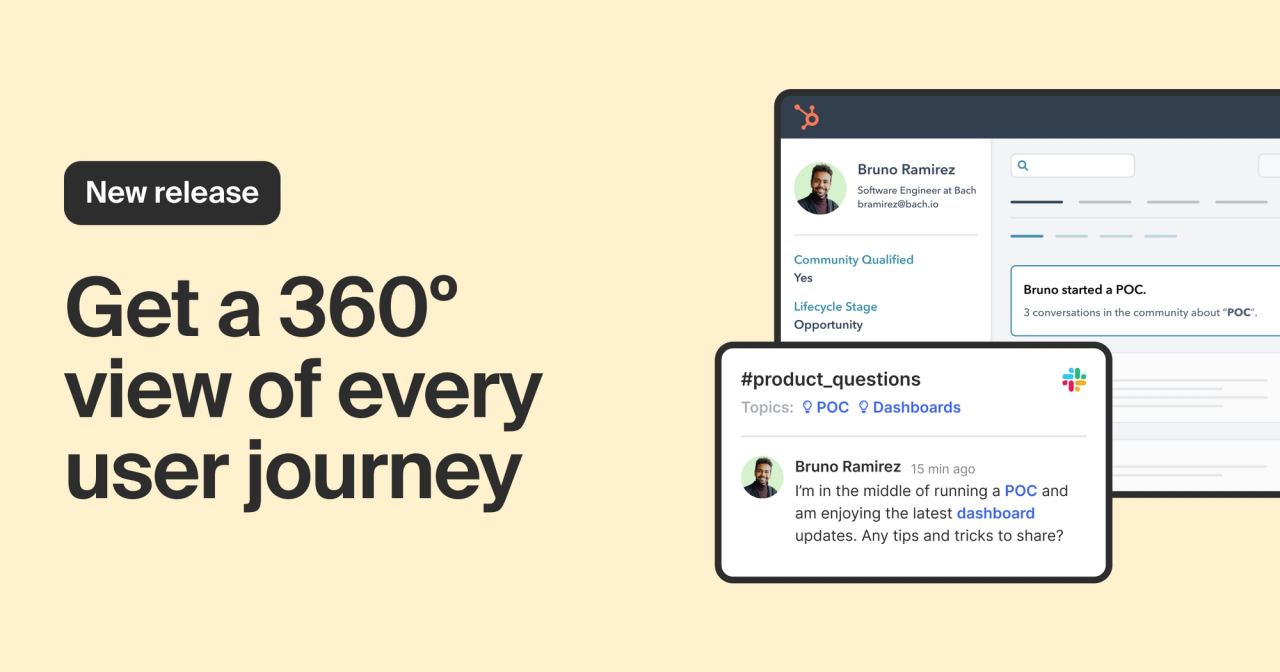Today, users increasingly adopt software before they buy. Instead of engaging in a sales conversation when adopting products, users are turning to community channels to get support, unlock value, and inform purchase decisions. As users shift their engagement to community channels, it’s important for not only community leaders but also leaders across all go-to-market functions to have context on user conversations taking place in the community. Common Room’s new HubSpot integration brings community intelligence to all go-to-market functions, giving sales, marketing, and community leaders a holistic view of the end-to-end user journey and the tools to take action. 🚀
Common Room’s HubSpot integration provides sales, marketing, and community leaders with a context-rich, unified view of their users in HubSpot and Common Room. In HubSpot, sales and marketing leaders can have context on how contacts and companies are engaging in the community. In Common Room, community leaders can see how their members are engaging with sales and marketing and push community qualified leads into HubSpot for sales teams to review. With this integration, leaders across all go-to-market functions can make more informed decisions to improve the user experience and take the right actions to grow the business.
👤 Personalize the end-to-end user journey from adoption to purchase
Modern software users increasingly engage outside of direct sales and marketing channels. Whether it’s posting a product question in Slack, expressing product appreciation on Twitter, or attending a Meetup, users choose to engage where it’s most convenient for them and expect software companies to meet them where they are. With the increase in the number and variety of engagement channels, it’s common for context to be lost as users advance from adoption to purchase. Sales reps may reach out to a user asking about use cases despite the user having already discussed them via community channels. Conversely, a user may have submitted a marketing form to join an early access program for a new product, but without context, community teams may separately reach out to the user to announce that product’s upcoming launch. This loss of context can lead to friction in the user journey and may put revenue at risk.
Common Room’s end-to-end integration with HubSpot provides sales, marketing, and community teams with a holistic view of user engagement so they can deliver a seamless adoption to purchase experience. In both Common Room and in HubSpot, GTM users can now view a unified profile and activity intelligence for each user. By knowing who a user is, where and how they are engaging, and what topics matter to them, sales teams can personalize outreach to deliver immediate value. And with context from sales and marketing activities, community teams can deliver more relevant content, events, and other programs based on where users are in the purchase process.

🤝 Engage users at the moment they are ready to purchase
As users increasingly shift to adopting before they buy, it’s important for sales teams to engage users at the right moment. Engaging users before they are ready could lead to a loss of trust. Engaging users too late could result in a loss of revenue. And because users often start their journeys in community channels, it’s common for leads to appear in the community well before sales teams are aware of them, furthering these issues and resulting in miscues during the purchase process that could jeopardize revenue.
Common Room’s community qualification (CQ) feature gives community teams the ability to automatically identify qualified leads from the community and create them as contacts in HubSpot. Community qualification criteria is customizable based on a variety of intelligent inputs which could signal purchase intent or ability to buy. Here are just a few examples:
- Qualify leads based on purchase intent
- Impact points (e.g. >10 impact points in the last 28 days)
- Specific community activities (e.g. 2 Slack posts)
- Topic mentions identified using Common Room’s AI-powered natural language processing (e.g. “pricing”)
- Industry (e.g. Financial services)
- Qualify leads based on their ability to buy
- Annual revenue (e.g. >$1M)
- Capital raised (e.g. >$100K)
- Role or title (e.g. “VP of Marketing”)
Once the community team identifies a community qualified lead and confirms they are ready for sales outreach, they can directly create the contact in HubSpot from within Common Room. The contact’s key information—first name, last name, email addresses, community qualification date—is automatically populated in HubSpot so sales can follow up with the interested customer at just the right moment.

🔮 Understand the business impact of your community investments
Quantifying the ROI from community investments can be challenging. We’ve heard from community, sales, and marketing leaders that they conceptually understand that investing in community generates value, but they cannot yet quantify exactly how much value is generated. As a result, leaders across all GTM functions aren’t sure about the optimal amount to invest in community channels and community teams are unable to communicate the impact of their work.
Common Room’s business impact reporting gives GTM teams visibility into how much business value the community is generating over time. Communities can generate value at all stages of the user journey:
- Users early in adopting the product may look to the community for help on understanding use cases and discovering immediate product value.
- Users looking to make a purchase decision may engage with others in the community who have recently gone through a similar decision process.
- Users who have become customers can share learnings with other users and partner with fellow power users to unlock deeper value from the product, influence product direction, and innovate on the use cases supported in the product.
Business impact reporting tracks organizations engaged in the community over time, split by organizations first seen in community, first seen in the sales pipeline, or only seen in community. Business impact reporting also supports analysis by key business attributes, like lifecycle stage, lead status, and total revenue, in order to more deeply understand the value generated by community. These views allow GTM to attribute customer growth and revenue to the right channels in order to make informed decisions about how much to invest in community and which channels to invest in.

With Common Room’s HubSpot integration, sales, marketing, and community teams can get a complete picture of every user’s journey so they can engage in a personalized and valuable way across every channel. Our HubSpot integration is currently in private beta and reserved for customers on the Enterprise plan; if you’d like to get access, let us know.
🚀
Ready to get started with Common Room’s integration with HubSpot? Sign in or sign up for free today. To get product help and share insights with 1,000+ community leaders, join our Uncommon community Slack.
